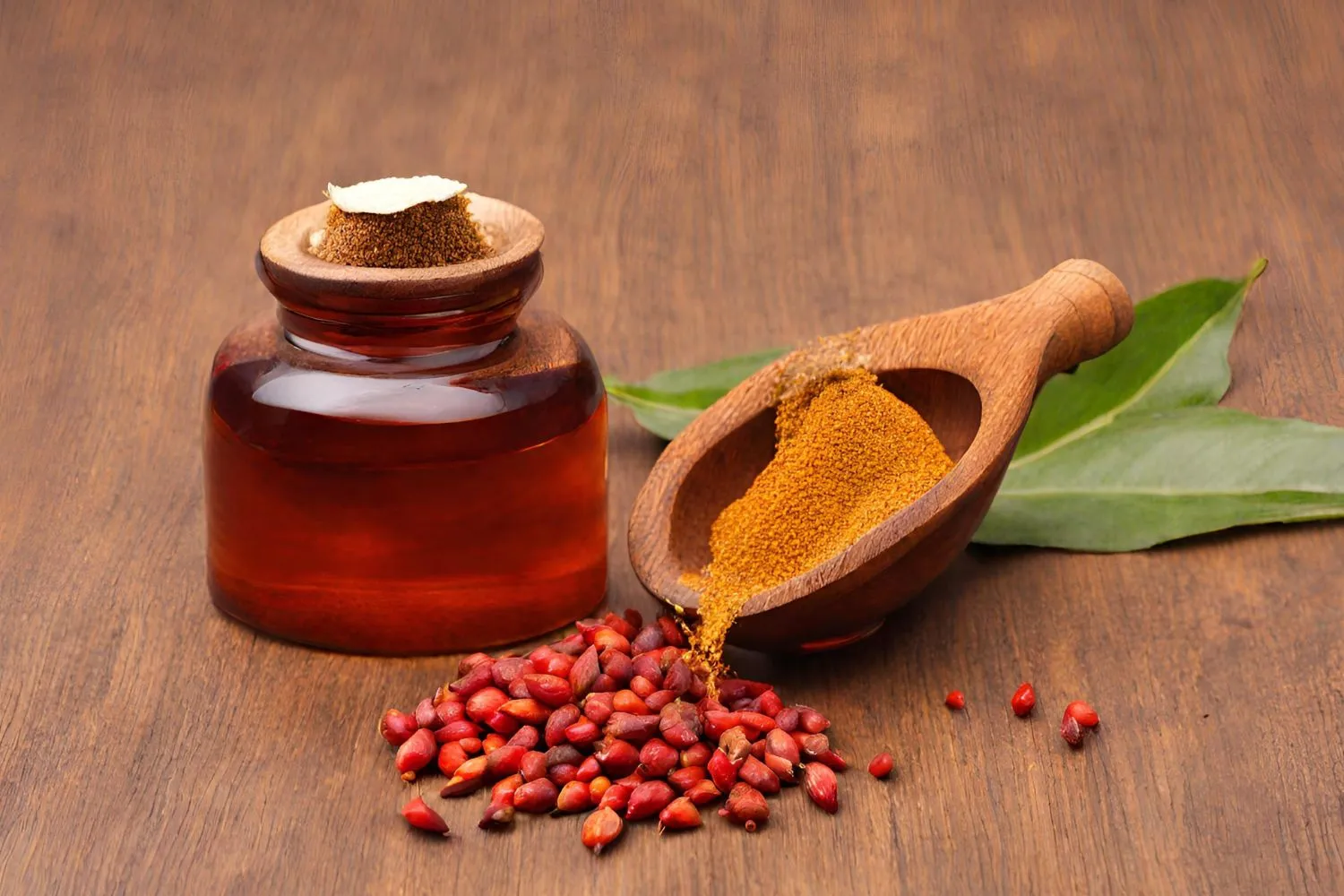Table of Contents
In the vibrant world of culinary oils, achiote oil stands out for its unique flavor profile and versatile applications. Derived from the seeds of the achiote tree, this distinctive oil is a staple in Latin American and Caribbean cuisines, imparting a deep, earthy flavor and a striking natural color to dishes. In this article, we’ll dive deep into what makes Achiote Oil Taste so special, exploring its taste, origins, health benefits, and how you can incorporate it into your cooking to elevate your dishes. Whether you’re a seasoned chef or a curious food enthusiast, join us on this flavorful journey to discover the essence of achiote oil.
Understanding Achiote Oil
Origin and History
Achiote oil, extracted from the seeds of the Bixa orellana plant, holds significance beyond mere culinary use. Originating from the tropical regions of the Americas, this oil has a rich history. For centuries, it has been integral not only in cooking but also in various rituals and as a natural dye. Moreover, the achiote tree, often referred to as the lipstick tree, produces seeds adorned with a vibrant red coating, which imparts the oil with its distinctive color.
Culinary Uses of Achiote Oil
In the culinary world, achiote oil is celebrated for its ability to add depth and character to dishes. It’s commonly used to marinate meats, season rice, and as a base for creating rich sauces. The oil’s earthy, slightly nutty flavor, with hints of pepper and nutmeg, makes it a unique addition to any kitchen. It’s particularly essential in dishes like pollo pibil, a traditional Mexican chicken dish, where its use is non-negotiable for achieving the authentic taste.
Health Benefits Associated with Achiote Oil
Beyond its culinary uses, achiote oil offers health benefits. Rich in carotenoids, it’s a powerful antioxidant. Regular consumption promotes heart and vision health. Additionally, its anti-inflammatory properties make it beneficial for overall well-being.
This introduction to achiote oil sets the stage for further exploration. Stay tuned as we delve deeper into its taste, homemade preparation, and innovative culinary uses. Achiote oil isn’t just an ingredient—it’s a gateway to rich, traditional flavors.
Describing Achiote Oil’s Taste
The taste of achiote oil is as intriguing as its history. When embarking on a culinary adventure with this oil, your palate is introduced to a tapestry of flavors. These flavors are earthy, peppery, and subtly sweet, with a hint of nuttiness that sets it apart from other oils.
Main Flavor Components
The flavor profile of achiote oil is primarily derived from the compounds present in the achiote seeds, including bixin, which contributes to its distinctive taste and color. This oil does not just add a visual appeal to dishes but also imparts a taste that can be described as mildly peppery with hints of sweetness. It’s this unique combination that makes achiote oil a favored ingredient in many traditional recipes.
Comparison with Other Cooking Oils
When compared to more commonly used oils like olive or vegetable oil, achiote oil stands out for its ability to impart both flavor and color to dishes. Unlike the neutral taste of many cooking oils, achiote oil brings its own character to recipes. It’s not just a medium for cooking but an integral part of the dish’s flavor profile.
How Achiote Oil Enhances Dishes
Indeed, achiote oil can turn a simple meal into an extraordinary experience. Its earthy and peppery notes are perfect for marinating meats. They give a depth of flavor that’s hard to match. In vegetarian dishes, it adds richness, enhancing the natural flavors of vegetables and legumes. Whether used in a marinade or as a finishing touch, achiote oil is versatile and impactful.
Exploring achiote oil’s unique taste shows its crucial role in many cuisines. It also encourages both chefs and home cooks to try its rich flavors. Next, we’ll see how you can make achiote oil at home. Doing so will elevate your culinary creations.
DIY Achiote Oil Taste Recipe
Making achiote oil at home is simpler than you might think. With just a few ingredients and steps, you can create this flavorful oil to use in a myriad of dishes. Let’s walk through the process.
Ingredients Needed
To start, you’ll need:
- 1 cup of a neutral oil, such as canola or vegetable oil, for its ability to absorb the flavors without overpowering them.
- 1/2 cup of achiote seeds, the star ingredient that will impart the oil with its distinctive color and taste.
Step-by-Step Cooking Guide
- Heat the Oil: In a small saucepan, gently heat the oil over medium heat. You don’t want it too hot; just warm enough to infuse the flavors.
- Add the Achiote Seeds: Once the oil is warm, add the achiote seeds. Stir occasionally and allow the seeds to simmer lightly. You’ll notice the oil beginning to turn a vibrant orange-red hue.
- Monitor the Heat: Keep the heat at a level where the seeds infuse their color without burning. If the seeds start to sizzle too vigorously, lower the heat.
- Strain and Store: After about 5 minutes of simmering, remove the pan from heat. Let it cool slightly before straining the oil through a fine mesh sieve or cheesecloth into a glass jar or bottle.
- Storage: Store your achiote oil in a cool, dark place. It can keep for up to a month, ready to add a splash of color and flavor to your dishes.
Tips for Best Results
- Quality of Ingredients: Use high-quality achiote seeds for the best flavor and color.
- Infusion Time: Don’t rush the infusion process. Allowing the seeds to simmer gently will ensure a richly flavored oil.
- Straining: Make sure to strain thoroughly to remove all seed remnants, preventing any bitterness in the oil.
Creating achiote oil at home allows you to bring a traditional flavor into your kitchen, adding depth and color to your dishes. This simple yet versatile ingredient can be a game-changer in your culinary endeavors, offering a bridge to exploring more authentic recipes.
Creative Ways to Use Achiote Oil in Cooking
With your homemade achiote oil ready, let’s explore some creative ways to incorporate this vibrant and flavorful oil into your cooking, enhancing dishes with its unique taste and color.
Traditional Dishes
Traditional Latin American cuisine offers a treasure trove of recipes where achiote oil plays a central role. One such dish is Cochinita Pibil, a slow-roasted pork dish that is marinated in achiote oil and citrus juices, wrapped in banana leaves, and cooked until tender. The oil’s distinct flavor profile deeply infuses the pork, creating a dish that’s bursting with taste and tradition.
Modern Culinary Innovations
Beyond traditional recipes, achiote oil can be a source of inspiration for modern culinary innovations. For example, try using it in salad dressings for an earthy twist, or drizzle it over roasted vegetables to add depth and a splash of color. Its versatility also extends to marinades for grilling, offering a subtle yet distinct flavor that compliments meats and fish beautifully.
Pairing with Ingredients for Enhanced Flavors
The robust flavor of achiote oil pairs wonderfully with ingredients like citrus fruits, garlic, and herbs. Its compatibility with legumes and grains makes it an excellent choice for vegetarian and vegan dishes.
For those interested in diving deeper into the culinary uses and benefits of achiote, Annatto Seeds Health Benefits provides further insight. Embracing achiote oil in your cooking is not only about adding a new ingredient; it’s about exploring new culinary landscapes and traditions.
Common Questions Answered
Delving deeper into the world of achiote oil, it’s natural to have questions about its uses, benefits, and culinary possibilities. Here’s addressing some frequently asked questions that might tickle your curiosity.
Can Achiote Oil Be Used for Baking?
Absolutely! While not traditional, using achiote oil in baking can impart a subtle, earthy flavor to breads and savory pastries. Its vibrant color also adds a visually appealing twist to your baked goods, making them stand out on the dinner table.
How to Store Achiote Oil?
Proper storage is key to preserving the freshness and flavor of achiote oil. Once cooled and strained, store the oil in a dark, glass bottle in a cool, dry place away from direct sunlight. This helps maintain its quality and prevents it from going rancid too quickly.
Are There Any Substitutes for Achiote Oil?
In recipes where the unique flavor and color of achiote oil are not central, you might use turmeric or paprika infused oil as a substitute. However, remember that while these alternatives can mimic the color, they will not replicate the exact taste profile of achiote oil.
For those eager to explore more about achiote‘s culinary journey and its applications, consider reading “What is the Flavor of Achiote?” for an in-depth exploration of this fascinating ingredient. Additionally, “Is Achiote Spicy Hot?” could shed light on common misconceptions about its taste profile.
As we conclude our exploration of achiote oil, we’ve journeyed through its origins, delved into its flavor profile, and learned to make it at home. Whether marinating meats, dressing salads, or baking, achiote oil brings tradition and innovation to your dishes. Its deep flavors and vibrant color tell a story of culture, history, and gastronomy.
Expanding Culinary Horizons with Achiote Oil
Once you’ve mastered making achiote oil at home, the next step is to weave it into your cooking. This vibrant oil can revolutionize the way you approach flavors in your kitchen. Let’s dive into some creative uses.
Elevating Everyday Dishes
Consider drizzling achiote oil over your breakfast eggs. Suddenly, a mundane morning staple transforms into a dish bursting with flavor. Similarly, a simple drizzle over roasted potatoes can turn a side dish into the star of your meal. The oil imparts a subtle earthiness and a beautiful color, making even the simplest dishes visually stunning and delicious.
Experimenting with Marinades
Achiote oil shines as a marinade for meats and vegetables. Its unique blend of earthy and peppery notes enhances the natural flavors of the ingredients. For example, marinating chicken in achiote oil with a squeeze of lime adds a depth of flavor that’s truly unparalleled. Furthermore, brushing it on vegetables before grilling can elevate their taste, transforming a basic grilled veggie platter into an exotic side dish.
Infusing Soups and Stews
Adding a tablespoon of achiote oil to soups and stews can introduce an entirely new dimension of flavor. Whether it’s a hearty bean stew or a light vegetable soup, the oil contributes a richness that deepens the dish’s overall taste profile. It’s an easy yet impactful way to add complexity to your favorite comfort foods.
By incorporating achiote oil into your cooking, you’re not just adding a new ingredient to your recipes. You’re embracing a tradition that spans continents and centuries. This oil, with its deep roots in Latin American and Caribbean cuisines, offers a connection to the past and an invitation to explore and innovate. Whether you’re a seasoned chef or a culinary enthusiast, achiote oil holds the promise of transforming the ordinary into something extraordinary. So, why not let your taste buds embark on this flavorful journey?
Summarizing the Essence of Achiote Oil
As we bring our culinary exploration of achiote oil to a close, it’s clear that this vibrant and flavorful oil is more than just a cooking ingredient; it’s a bridge to rich cultural traditions and a testament to the diversity of global cuisines. Its unique flavor profile, health benefits, and versatility in cooking make it a cherished staple in kitchens around the world.
Final Thoughts on Achiote Oil’s Taste and Uses
The journey through the world of achiote oil reveals an ingredient that is both complex and versatile. Its ability to impart a deep, earthy flavor and a beautiful golden hue to dishes makes it indispensable in certain recipes and a source of inspiration for culinary innovation. From traditional dishes that have been passed down through generations to modern culinary creations, achiote oil has proven to be a key player in the tapestry of flavors that define our global culinary heritage.
Encouragement to Experiment with Achiote Oil
If there’s one takeaway from our exploration, it’s the invitation to experiment with achiote oil. Whether you’re drawn to its health benefits, intrigued by its history, or simply looking for a way to add depth and color to your dishes, achiote oil offers endless possibilities for creativity.
As you embark on your own culinary adventures with achiote oil, remember that cooking is not just about following recipes. It’s about making each dish your own. With achiote oil, you have a versatile ingredient that invites experimentation and innovation, promising to infuse your meals with not just flavor and color but with stories and traditions from across the globe.
In embracing achiote oil, you’re not just adding a new ingredient to your pantry. You’re opening up a world of culinary possibilities, ready to be explored and savored. So go ahead, let your taste buds travel, and discover the rich, earthy essence of achiote oil in your cooking endeavors.





